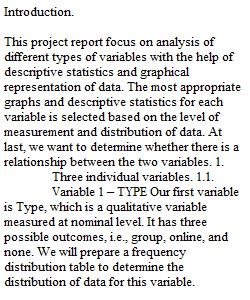


Q Introduction Your instructor will provide you with a data file that includes data on five variables: SALES represents the number of sales made this week. CALLS represents the number of sales calls made this week. TIME represents the average time per call this week. YEARS represents years of experience in the call center. TYPE represents the type of training the employee received. Part A: Exploratory Data Analysis Preparation • Open the files for the course project and the data set. • For each of the five variables, process, organize, present and summarize the data. Analyze each variable by itself using graphical and numerical techniques of summarization. Use Excel as much as possible, explaining what the results reveal. Some of the following graphs may be helpful: stem-leaf diagram, frequency/relative frequency table, histogram, boxplot, dotplot, pie chart, bar graph. Caution: not all of these are appropriate for each of these variables, nor are they all necessary. More is not necessarily better. In addition be sure to find the appropriate measures of central tendency, the measures of dispersion, and the shapes of the distributions (for the quantitative variables) for the above data. Where appropriate, use the five number summary (the Min, Q1, Median, Q3, Max). Once again, use Excel as appropriate, and explain what the results mean. • Analyze the connections or relationships between the variables. There are ten possible pairings of two variables. Use graphical as well as numerical summary measures. Explain the results of the analysis. Be sure to consider all 10 pairings. Some variables show clear relationships, while others do not. Report Requirements • From the variable analysis above, provide the analysis and interpretation for three individual variables. This would include no more than 1 graph for each, one or two measures of central tendency and variability (as appropriate), the shapes of the distributions for quantitative variables, and two or three sentences of interpretation. • For the 10 pairings, identify and report only on three of the pairings, again using graphical and numerical summary (as appropriate), with interpretations. Please note that at least one pairing must include a qualitative variable and at least one pairing must not include a qualitative variable. • Prepare the report in Microsoft Word, integrating graphs and tables with text explanations and interpretations. Be sure to include graphical and numerical back up for the explanations and interpretations. Be selective in what is included in the report to meet the requirements of the report without extraneous information. • All DeVry University policies are in effect, including the plagiarism policy. • Project Part A report is due by the end of Week 2. • Project Part A is worth 100 total points. See grading rubric below. Submission: The report, including all relevant graphs and numerical analysis along with interpretations Format for report: A. Brief Introduction B. Discuss 1st individual variable, using graphical, numerical summary and interpretation C. Discuss 2nd individual variable, using graphical, numerical summary and interpretation D. Discuss 3rd individual variable, using graphical, numerical summary and interpretation E. Discuss 1st pairing of variables, using graphical, numerical summary and interpretation F. Discuss 2nd pairing of variables, using graphical, numerical summary and interpretation G. Discuss 3rd pairing of variables, using graphical, numerical summary and interpretation H. Conclusion Part A: Grading Rubric Category Points % Description Three individual variables - 12 point each 36 points 36% Graphical analysis, numerical analysis (when appropriate), and interpretation Three relationships - 15 points each 45 points 45% Graphical analysis, numerical analysis (when appropriate), and interpretation Communication skills 19 points 19% Writing, grammar, clarity, logic, cohesiveness, adherence to the above format Total 100 points 100% A quality paper will meet or exceed all the above requirements
View Related Questions